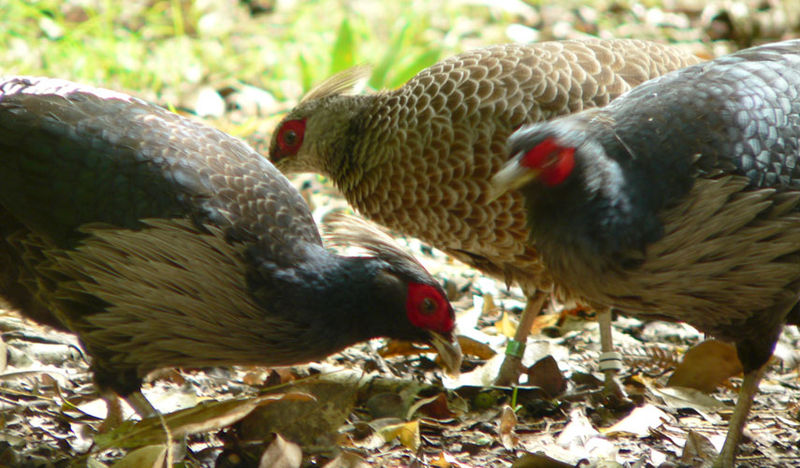First stop yesterday was Kipuka Puaulu, a rainforest bird park on the lower slopes of Mauna Loa. We heard more birds than we saw, aside from the many pheasants crisscrossing the trail. Hawaii is absolutely infested with pheasants. There’s a phrase I don’t find myself typing very often.
We took a drive part of the way up Mauna Loa itself because there’s supposed to be a terrific overlook up there of all the smaller volcanoes. The drive up was like a trip through Middle Earth; the vegetation kept changing every time we gained a little elevation, and I didn’t recognize any of it.
Then we finally got up to the lookout point and all we saw was swirling vog. That’s not a typo, it’s short for “volcanic smog,” the mixture of sulfur dioxide and water vapor emitted by the volcano. The lower slope of the volcano is pretty in a menacing, otherworldly way. It’s mostly red volcanic rock with tough shrubs growing out of it, many bleached white for some reason — maybe the omnipresent sulfurous fumes?
There weren’t as many birds as down in the bird park, but the ones we saw were cool. There are a lot of little red songbirds with wildly curved beaks. The web informs me that they’re called ‘I’iwi or Scarlet Hawaiian Honeycreepers. They have a complex song that Anna compared to R2D2.
We drove down off the volcano, where it was a damp sixty degrees, to Hilo, where it was sunny and eighty. Hilo reminds me of San Francisco — it has that frontier-town architecture mixed with sweeping ocean views and palm trees. The ocean front has a few fancy hotels but mostly it’s spacious parks full of immense, otherworldly banyan trees. This seems like amazingly progressive urban planning for a small, not-very-prosperous city, but we later learned that the parks are pragmatic. Every time there’s a tsunami, everything along the bay gets leveled, so they finally figured that there’s no point in letting people build anything there. The hotels are “tsunami-proof,” which just means that the bottom floors have flimsy walls that are meant to be easily swept away, leaving the support pillars intact.
Anna’s main objective was the Hilo farmer’s market. The Kona farmer’s market was a dozen hippies in tents, but the Hilo market is a serious institution. It covers a couple of full blocks and includes the full diversity of tropical agriculture. There are also people selling orchids, aloha shirts and various handcrafts ranging from tourist junk to gorgeous high-end woodwork. Lunch was melt-in-your-mouth kalua pig with sweet potatoes, rice, salty salmon and ti leaves (I had thought they were saying “tea leaves” but no.) I also tried a kind of spam sushi, which tastes much better than it sounds. We also had what I think were banana spring rolls, and drank out of a young coconut that the vendor hacked open with a machete. Very Gilligan’s Island.
After the farmer’s market we took in Liliuokalani Park and Gardens, a big formal Japanese garden and arboretum by the water. The place is full of zebra doves, Hilo’s version of the pigeon. The water features communicate with the ocean and there were little kids fishing in them. This park isn’t just for tourists, it seems to be a really popular hangout for Hilo’s residents. People were barbecuing, skateboarding, jogging, hanging out. We saw Hawaii’s entire goth population, all three of them, looking like they really would prefer to be somewhere else. In the bay right by the picnic tables we saw a few manta rays grazing in the shallow water.
I was spellbound, but the Hawaiians were totally jaded. The kids passing by were all talking about the much bigger ones they’ve all seen.
I was looking at a kid’s book about Barack Obama a couple of days ago, and it had a quote from Michelle: “To understand Barack, you really have to understand Hawaii.” I’m not sure what she meant by that, but maybe part of it is that he has the Spock-like affect because after growing up here, nothing surprises him.



